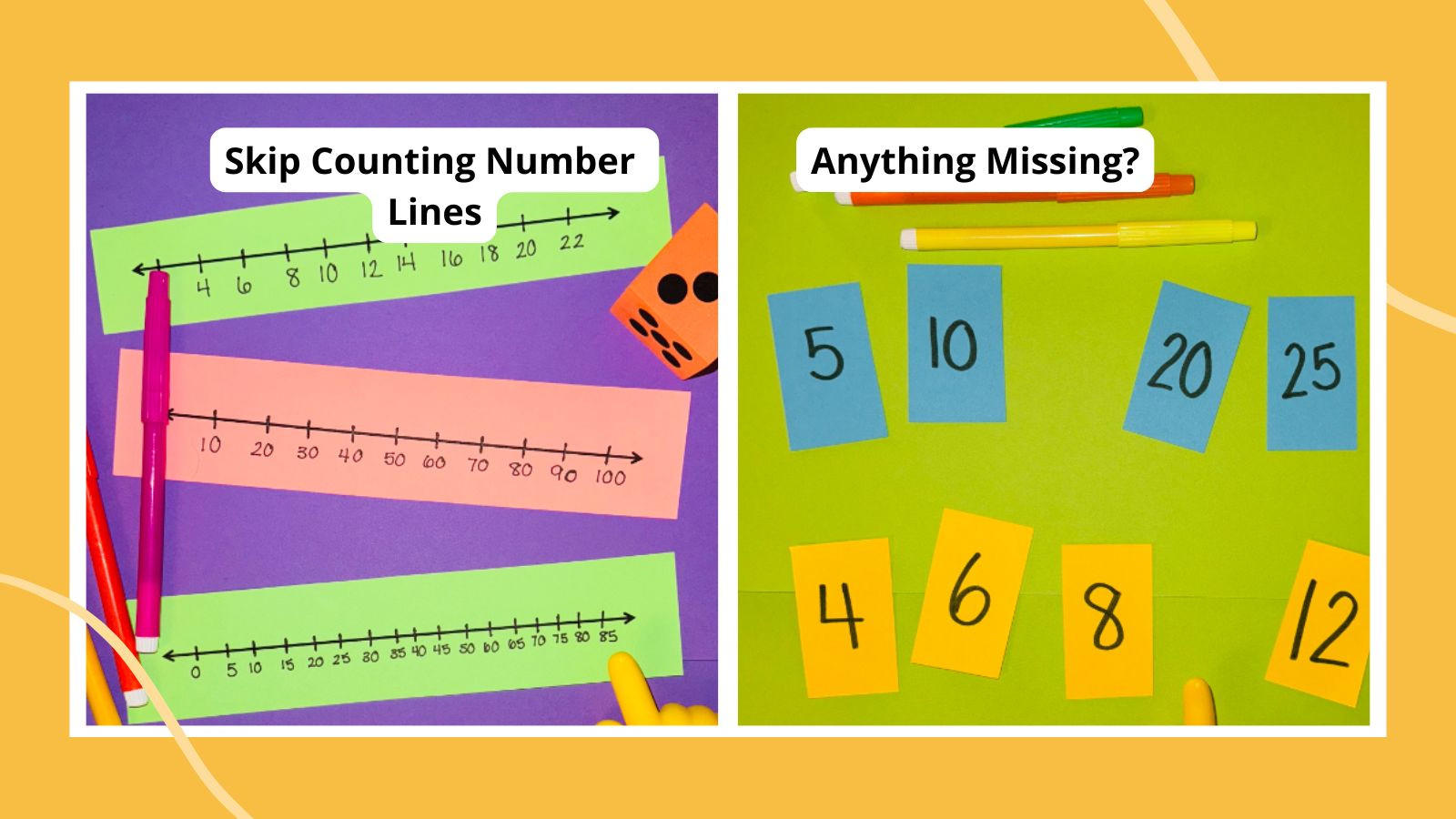The first math most kids are aware of doing is counting. At first, it’s just a rote calling out of numbers in sequence. Then it’s almost always by ones as they count objects and learn one-to-one correspondence. That’s foundational. However, once you start to count a lot of objects by ones, things get pretty slow, and the chances of making an error increase. What can you do? Try skip counting!
Skip counts involve grouping and patterns, two other big ideas in elementary math. A pile of 100 peanuts is counted a lot more quickly by 2’s, even more so by 5’s, and with 10’s, forget about it. Over and done in seconds. Skip counts are fun and useful for kids, and they usually have a bit of a rhythm to them, so they’re easy to learn. Try some of these activities with your class and you’ll see it’s true.
1. Skip-Counting Read-Alouds
Use read-alouds as a springboard to some skip counting together. You may want to start with Two Ways To Count to Ten by Ruby Dee (Square Fish, 1990). Skip counting solves a big problem in this story. It’s a Liberian folktale about a king who organizes a contest to seek his successor. The challenge seems impossible at first: Contestants must throw King Leopard’s spear up in the air and count to 10 before it comes back to earth again. But if you know how to skip-count …
Other skip-count read-alouds to give a try include:
2. Skip-Counting Number Lines
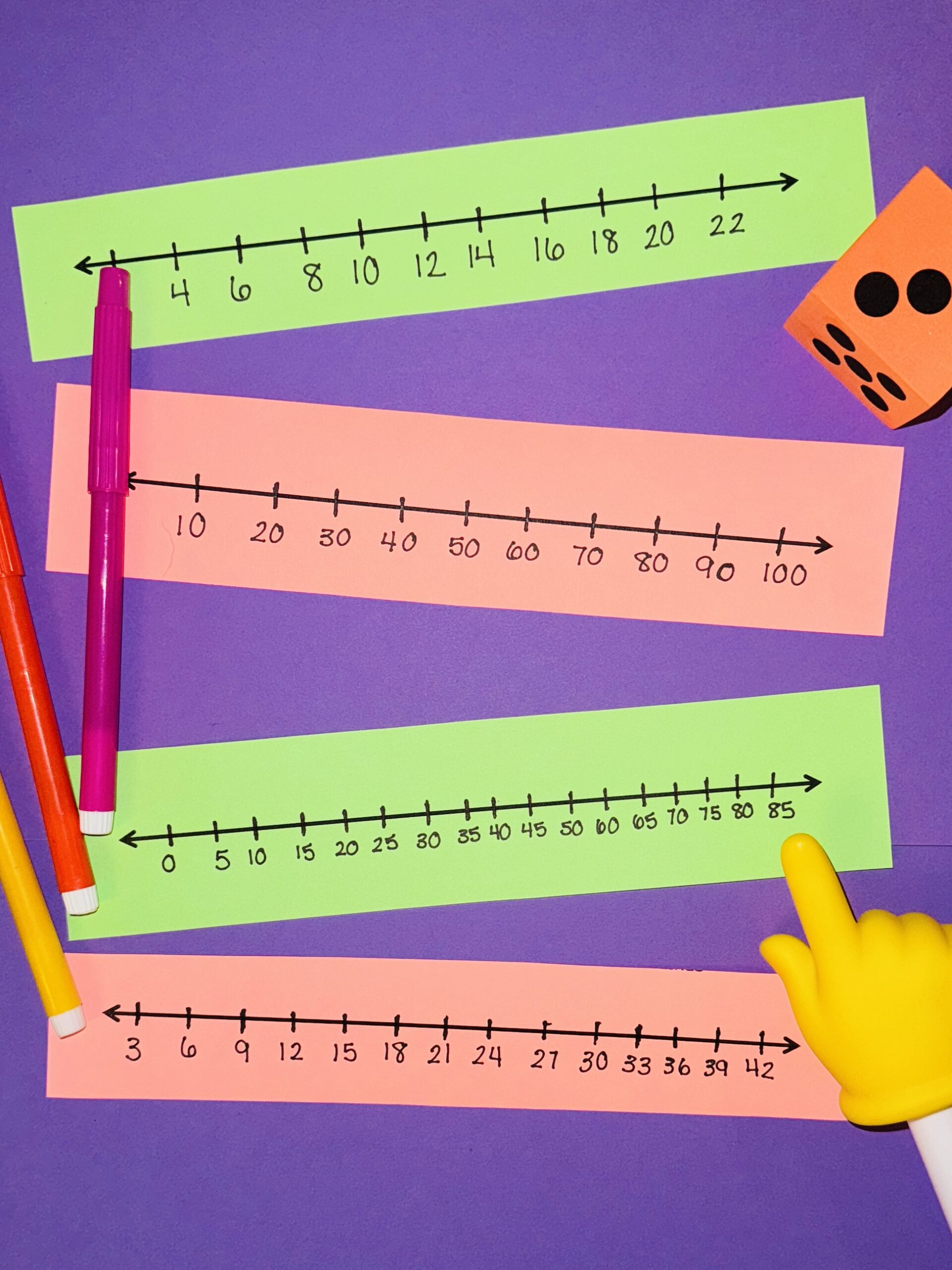
Prepare different-colored sentence strips showing different skip counts, almost like short number lines. These are a good visual reference. Each should have a number and nine multiples of that number. For example, the first strip could be 1, 2, 3, 4, 5, 6, 7, 8, 9, 10, the second strip 2, 4, 6, 8, 10, 12, 14, 16, 18, 20, the third 3, 6, 9, 12, 15, 18, 21, 24, 27, 30, etc.
Practice reading the strips in various ways:
- Orally while looking at the wall strips and taking turns; individual students, pairs, table groups, row groups, bus riders, walkers, and then orally with eyes closed in those same groupings.
- You or a student reads some of the numbers from a strip and then stops. The class says the next number aloud.
- The teacher and students alternate saying the numbers. For example, you say “3,” the class says “6.” You say, “9,” the class says “12,” etc.
3. My 100 Fingers
This is some super fun skip-counting art! Have each student dip one hand into paint and then press it onto a large sheet of paper (just larger than the students’ hands). Each student does this 20 times.
After the handprints dry, each student should write 5 in one color on each handprint. This is for the 5 fingers on the hand. Under each hand, write the numbers reflecting a skip count.
For example, on the first handprint, write 5 in blue, and under it write 5 in red. On the second handprint, write 5 in blue and 10 in red under it. On the third handprint, write 5 in blue and 15 in red under it, and so on.
4. Hopscotch Skip Counting
Outside on the playground, use chalk to create the target skip counting in a hopscotch “board.” Students call out the skip count numbers as they hop on each one.
- You can draw two or three different hopscotch boards, each with its own skip-count numbers. Even better, have kids create their own.
- You can throw in some “clunkers”—numbers that DO NOT fit that skip-count pattern, to keep students thinking and staying on the right pattern!
5. Skip-Counting Sticks
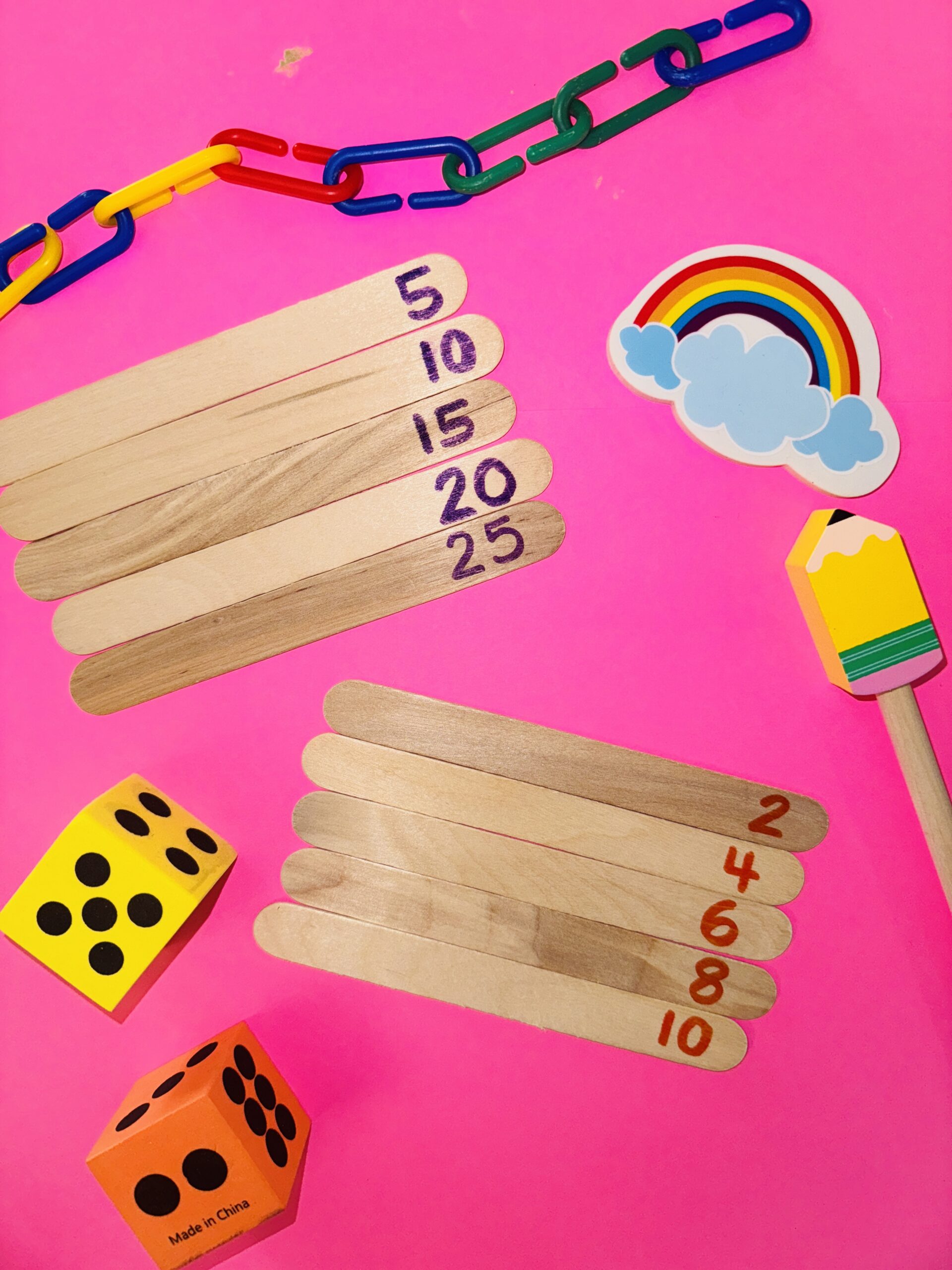
Make a set of 10 Popsicle sticks for each skip-count pattern by writing each number for the pattern on the stick. Colorful sticks make it even more engaging. Keep the sets of sticks together with a rubber band or in a ziplock bag.
Students select a bag, empty it, and lay out the sticks to find the lowest number, then arrange the rest of the sticks in the skip-count pattern. When the bag is complete, they put the sticks back in and trade bags. These are great for kids to make on their own too.
6. Dot-to-Dot Skip-Counting Sheets
Dot-to-Dot Skip Counts provide fun practice with some art thrown in. These are easy to find for free online for teachers or you could create your own. Students draw the dot-to-dot lines, the picture is revealed, and then they have a chance to color it in. If you want to adapt them to certain specific skip counts, you can always white-out the numbers on there and write in the ones you want kids to work on. You can also invite kids to try to create their own.
7. Skip-Count With Paper Clips
This is a simple hands-on model for skip counts kids will enjoy making. On the edge of paper plates, write the target skip-count pattern, leaving space between the numbers. The student will slide the number of paper clips for that pattern in the space between the numbers. For example, if the skip-count pattern is 4’s, on the edge of the paper plate, there will be 0 then a space, 4 then a space, 8 then a space, 12 then a space, and so on. In those spaces, the students will put four paper clips. This becomes a counting manipulative and model.
8. Action Skip Counting
Early learners love to move while they learn. As students recite or call out skip counts, have them do an action as well: clapping, nodding, stomping, jumping jacks, hopping, etc. If you are doing jumping jacks, you would count, “2!” and do two, then do two more and count out, “4!” Do two more and count out, “6!” It’s a good mental and physical workout!
9. Skip Counting With Dice
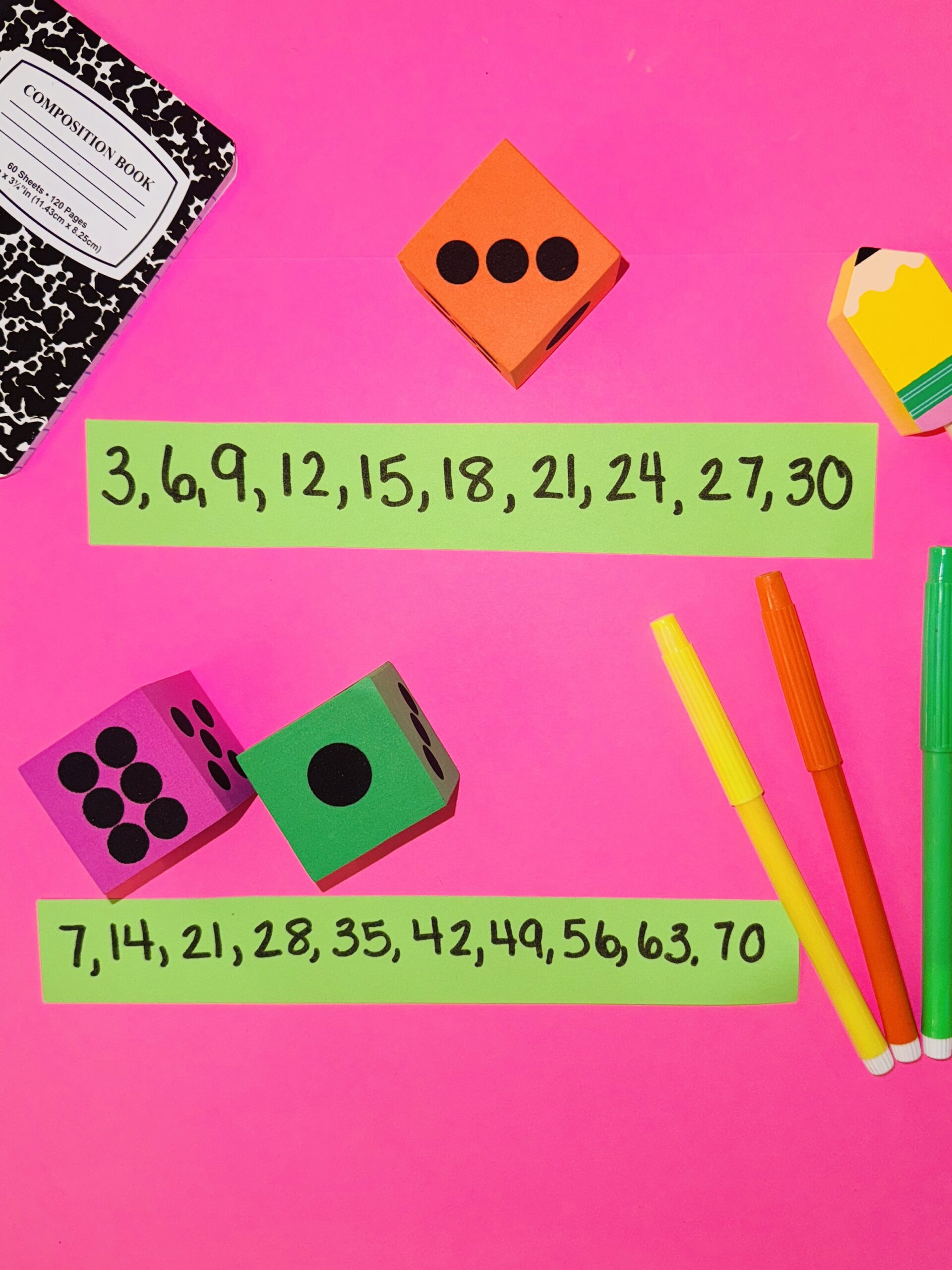
This activity can get kids into a lot of different kinds of skip counts. It also lays a foundation for multiplication and thinking about multiples. Based on the level of skip counting targeted, give each student one or both dice, a sheet of paper, and a pencil.
Students roll a die (or dice). The number rolled is the first number of the skip-counting pattern. On the sheet of paper, students write 10 numbers in that skip-count pattern. So, if I roll a 3, I would write 3, 6, 9, 12, 15, 18, 21, 24, 27, 30.
With two dice I might roll a 7. This is a more challenging pattern, but it would begin with 7 and go 14, 21, 28, 35, 42, 49, 56, 63, 70.
10. Skip-Counting Dot Chart Art
Give students a sheet of paper for each skip count you are working on. Have students draw 10 circle or square outlines, or the sheet can be premade with these. Provide markers, crayons, or colored pencils. Direct students to draw the number of dots in the circle or square outlines for that skip-counting chart. For even more artistic fun, provide paint and cotton swabs for the student to create their dots with.
11. LEGO Skip-Counting Models
A variety of different hands-on models help students learn math ideas. LEGO bricks can serve as one model for numbers needed for the skip-counting pattern you want to work on. The number of raised dots on the LEGO bricks will be the skip-count number. Students can put the LEGO bricks on a LEGO grid, on a sheet of paper, or simply on their desk. Count together as students touch each piece along with the count.
12. Skip-Counting Cups
This is a good partner activity as students can split the work and help check each other’s counts. Make a set of 10 cups for each skip-count pattern by writing each number for the pattern on the side of the cup.
Give individual students or pairs of students a set of these cups. Students count and place small items such as LEGO bricks, connecting blocks, counting bears, or Popsicle sticks into the cups according to the number on the side.
When finished, each cup must be filled with the correct number of items and the cups must be in the correct sequence. Students will “read’ their cups to each other or the teacher.
13. Nickel or Dime Skip Counting
We use skip counts a lot in real life when we are counting money. To give students some practice, prepare a paper or laminated card with cent amounts ending in zero or five. Provide sets of nickels and dimes (real or play money).
Direct students to read the amount and line up the nickels or dimes to make that amount. Amounts ending in zero can be shown with nickels or dimes, not combinations. Amounts ending in a five must be shown with nickels only, not combinations.
For example, if the amount is 30 cents, show: nickel, nickel, nickel, nickel, nickel, nickel OR dime, dime, dime.
If the amount is 45 cents, show: nickel, nickel, nickel, nickel, nickel, nickel, nickel, nickel, nickel.
14. Skip Counting on a Measuring Tape
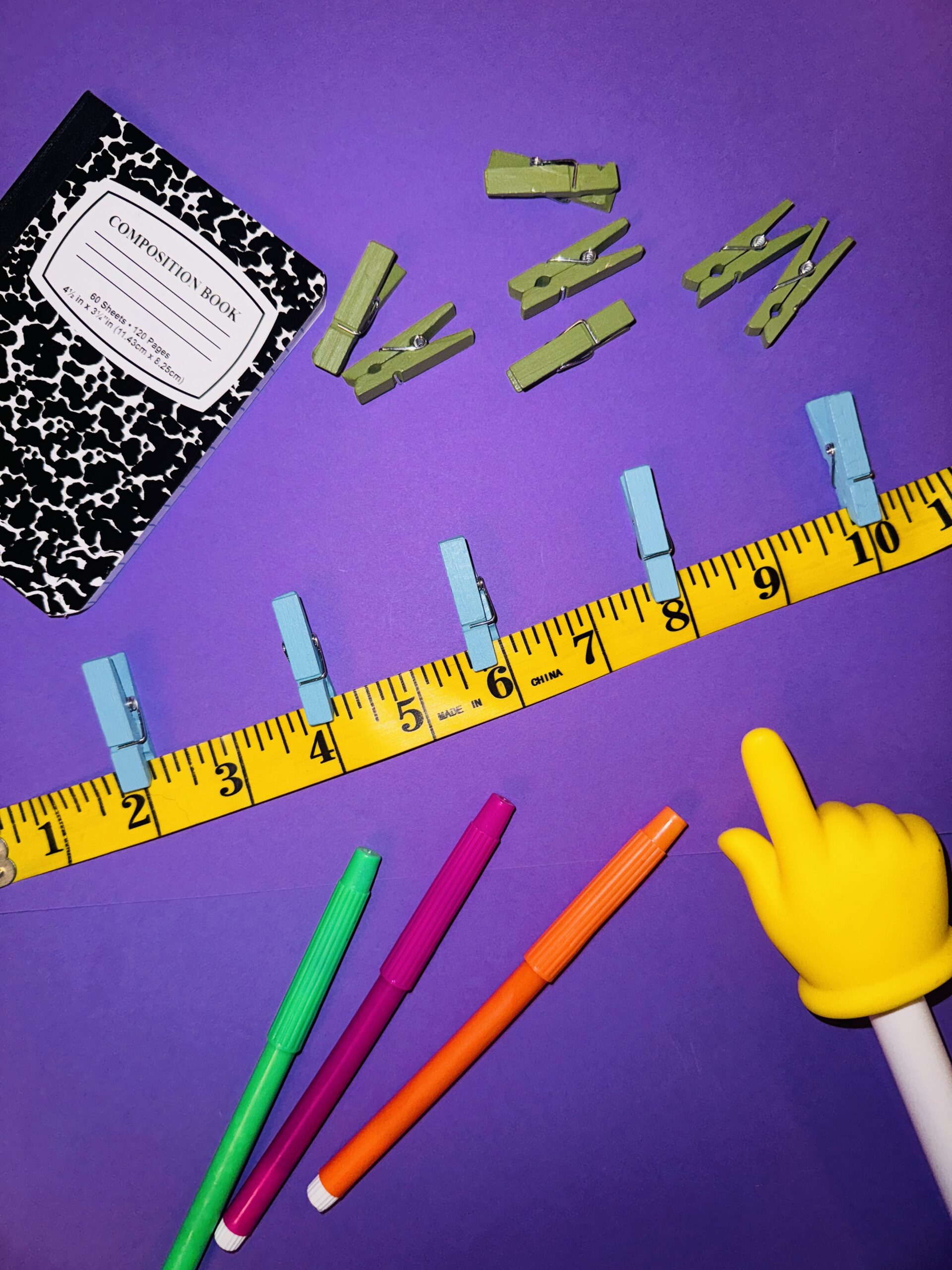
Combining skip counting and the idea of a measurement tape as a number line is a good association for kids to make. It’s best done individually. Each student is given 10 clothespins and a measuring tape. Assign each student a starting number, or you can have them randomly pick a number from a prepared stack of number cards.
Students put a clothespin on the start number on the measuring tape and continue to skip-count, putting clothespins on the next nine numbers in the pattern. It’s fun to suspend these like a clothesline if you have room.
15. Make a Skip-Count Puzzle
Kids love puzzles. These are simple ones, but you have to know your skip counts. Give each student a piece of drawing paper and have them draw pictures from their favorite read-alouds, illustrations from science or social studies topics, or a design. Instruct them to leave a margin of about an inch at the bottom.
Then using a ruler, you or the student can evenly divide and mark the bottom margin of the picture into 10 sections. In each section, write the numbers of a skip-count pattern in sequence. Laminate the picture, then use a paper cutter to cut it into 10 strips along the marks at the bottom. Keep each puzzle together with a clip or in a ziplock bag. Students can share and trade puzzles, trying to put them together using the skip-count numbers at the bottom and self-checking by looking at the puzzle picture.
16. Skip-Count Pattern Posters
Draw large-size outlines of numbers 1 through 10 on poster paper. These are the “number posters.” Then use pads of sticky notes or other small-sized papers, 10 of which will fit inside the large number outline.
Assign a number poster to a student or pair of students, who will write the skip-count pattern numbers on the 10 small pieces of paper. Students check with a partner or other source to ensure their numbers are correct, then attach them (with tape or glue) to the poster in sequence. Putting these all together can make a nice display.
17. Anything Missing?
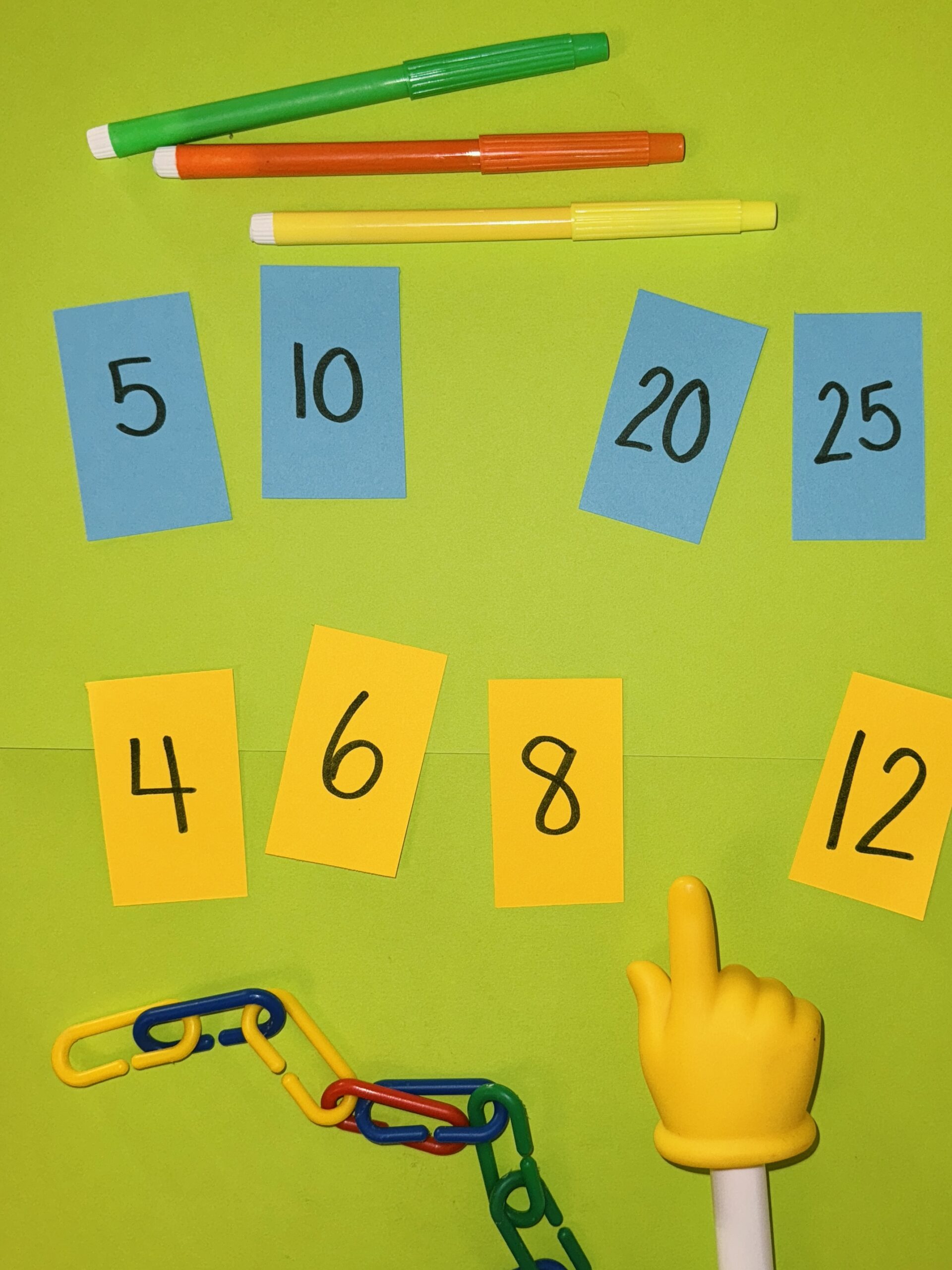
Give each student a set of 10 blank index cards. Students pick a skip-count pattern to make on the cards. They can start with any number they want. For example, if they are going to do 5’s, they don’t have to make the first card a 5. They can start with 15 or 20 or any multiple of 5 they want. After students have made their sets, have them pair up and trade sets, but before they do, explain to students that they should each remove one card from their set before they give it to the partner.
When partners get the set, they should put them in order and try to determine the missing card. The only other rule is that you can’t make the missing card the first or last card of the sequence.
18. Puddle-Stomping Skip Counting
Here’s a good activity to get kids moving. You can do this inside or outside depending on the space you have. Cut out 10 puddle-shaped ovals from blue paper for each set of skip-count patterns you want to practice. Write the skip-count numbers on the 10 puddles. Lay out the puddles in the correct sequence, then start the stomping and “splashing.”
To make this more challenging, consider arranging the puddles in a random sequence and/or include numbers that are NOT part of that skip-count pattern. Kids can make these sets as well. Sometimes they want to make one to use at home.
19. Counting Stations
Set up 10 counting stations around the room. Each station should have a set of small manipulatives like counting bears, chips, buttons, or similar in a container. Each station should also be marked with a letter and a number, which will be the skip-count number.
Partner students up and give them a clipboard, pencil, and lined paper. When students get to the station, they empty the container and begin to skip-count by the station number. The first time, they count aloud. The second time, students write the letter of the station and then write the skip count they did there with all 10 numbers.
When done, rotate to another station and continue until all are complete.
20. Cover Up
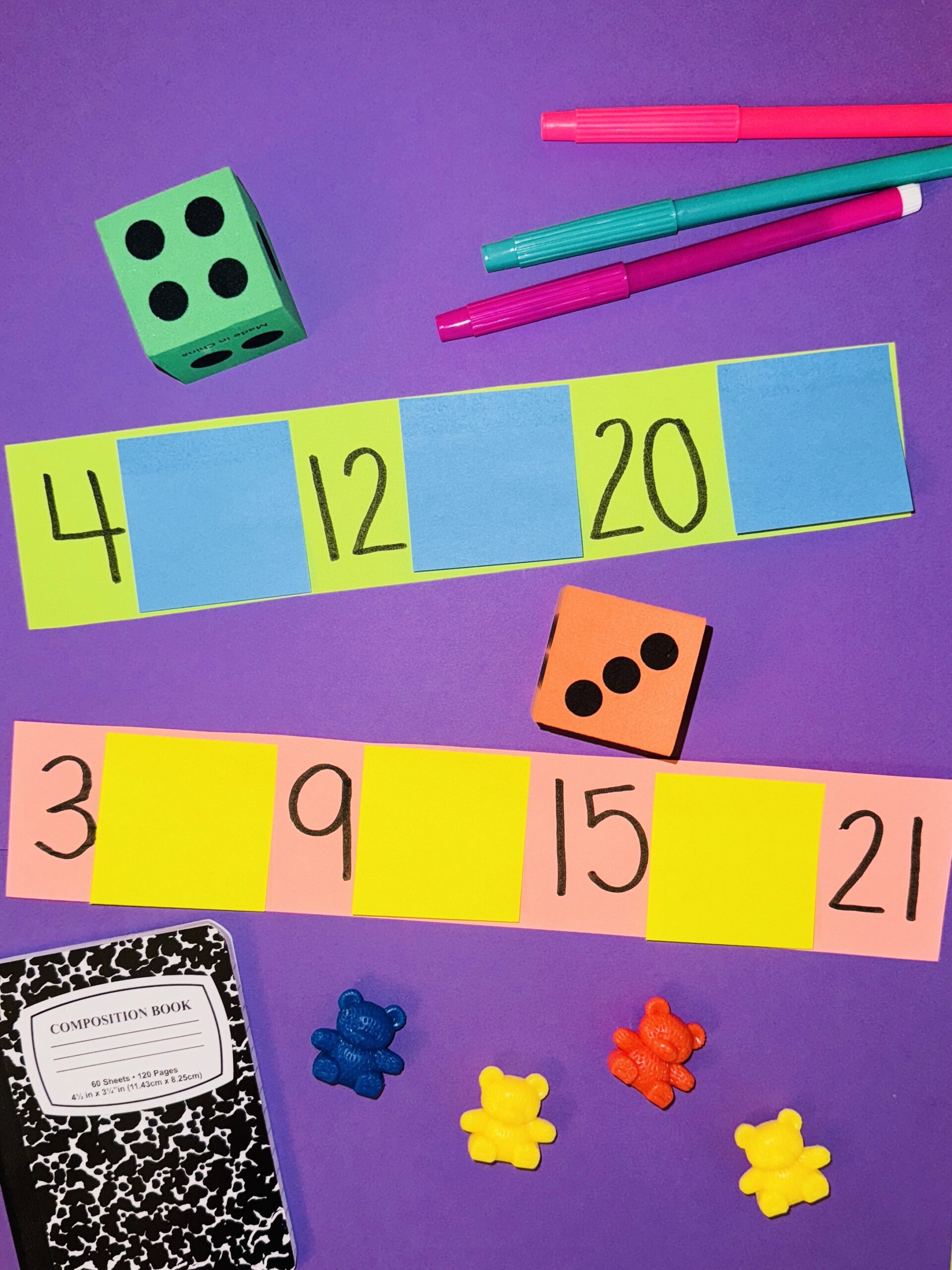
Provide students with a blank sentence strip sheet, a pencil, and some sticky notes. Tell them their number or let them choose from a stack of number cards or roll dice. That is the first number of their skip-count pattern. They write the pattern out on the number strip and then use the sticky notes to cover up three numbers. At that point, they are ready to trade with a partner and see if they can figure out which numbers are covered up.
21. Skip-Count Rhymes
Brainstorm together with kids on creating some fun rhymes based on skip counts. Share the classic “2, 4, 6, 8, who do we appreciate?!” as a model. Explain to kids, “We are going to make some more skip-count rhymes like this one. We will call out four skip-count numbers in a row, and then think of a rhyming sentence to put on the end. For example, how about 5, 10, 15, 20 … now I think I’ve eaten plenty!”
Ask if anyone else has any rhyming endings for 2’s or 5’s. Try them out. Then begin to try others like 3’s, 4’s, 10’s, and so on.

